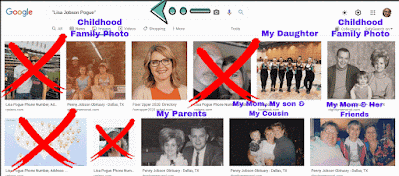Despite the fact that I enjoy writing, it's been awhile since I've written a blog post. During my second year as an Instructional Design Coach, I decided to pursue a second Masters Degree in Educational Technology Leadership. My next few posts will be in response to a class in Web 2.0 Technologies at Texas A&M University - Commerce.
Our professor asked us to do a "Vanity Search" to learn more about our digital footprint, or online presence. As a professional educator, I like to think I am careful about what image I create on the "interwebs," as one of my favorite Tik Tokers calls it, yet I was still a little nervous to begin the "Google Search" of myself.
I began my search with the name I most commonly go by, Lisa Pogue. On the first page of the search, I found my professional educator Linked In profile and my @RCHS_Pogue twitter account. I learned there are several other Lisa Pogues, one of which has a large online presence with her business, DC Lending. Her information was more prominent than mine. Under images and videos, all but one of the images were from my professional Twitter account, and then there was an image of my daughter where my name was mentioned in a senior spotlight article.
So far so good on the Google Search, but everyone knows there are other pages to "the Google." On the second page of the search for myself, I found a link to my Goodreads profile, my YouTube channel with my most recent video from the first summer session class. In addition there was a link to the Show Me account I used when I was an elementary GT specialist 7 years ago, as well as my Donors Choose Account. Once again, the majority of the links were for Lisa Pogue with DC Lending, so I refined my search to "Lisa Jobson Pogue," including my maiden name.
This query brought up more links specific to me, and less for Lisa, the mortgage professional. From this search, I found a link to my Facebook page, specifically to a post about senior yard signs for my daughter's senior class, some of the same links as the previous search, but quite a bit more images. The images were mostly family photos that were posted on my mom's obituary, some were from my professional Twitter account, and one directory picture from a professional development event. Under videos, the link to my mom's obituary video came up, as well as where I had signed obituary pages for a cousin and a friend.
When I added my middle name to the search, Lisa Diane Pogue, or Lisa Diane Jobson Pogue, a few people- search links came up, which was a bit disturbing as they had very accurate information about where I lived and even my phone number. They also had a few erroneous phone numbers which I have never possessed This search also led to a page in my UT Alumni directory published in 2001 and a recent lawsuit filed against me in regards to a wreck my daughter had in 2018. (For the inquiring minds, this lawsuit was settled after they put my 18 year old daughter through a deposition for a wreck she had at the age of 16 but I digress . . .)

For grins, I also did a search for my previous married name, Lisa Chapa, Lisa Jobson Chapa, and Lisa Diane Chapa. Being as I was married from 1990 - 1996, long before "the Googles" were popular, there wasn't much to be found. There was a link to a fastpeople search engine, but linked to me, Lisa Pogue. In addition, there was also a well-respected medical professional named, Lisa Chapa, who has a respectful digital footprint about her work as an oncologist - nice!
Reflecting on my Vanity Search, I am pleased with my digital footprint and how it would lead people not only to positive information about me, but more importantly about my professionalism as an educator. It confirmed that most of my social media accounts are private, and therefore do no not come up in search engine results. Mostly, it made me consider the fact that I didn't grow up with the internet, social media, or cell phones, so it might be easier for me to consider the ramifications of a negative online presence or a spur- of-the-moment post made in anger that could remain forever, and I wonder if my own children will be able to say the same about their digital footprint when they are 52 years young :). As a "more-mature" user of the internet, and at the risk of sounding like an "official old-person," I do worry about the next generation and the fall out of their tendency to put their private lives out for all of the world to see. I worry about how decisions made by youth, before their brains are fully developed, will follow them into their future careers, and then again I wonder, by then, will it even matter? As much has changed in my lifetime and even in my children's lifetime, will the next generation's ideas of a positive digital footprint be different than mine today?







